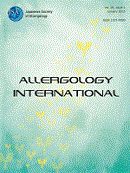72 巻, 3 号
選択された号の論文の19件中1~19を表示しています
- |<
- <
- 1
- >
- >|
Editorial
-
2023 年 72 巻 3 号 p. 357-358
発行日: 2023年
公開日: 2023/07/07
PDF形式でダウンロード (228K)
Invited Review Articles
Review Series:Current topics on urticaria, and urticaria-related diseases introduced in the Japanese Urticaria Clinical Practice Guidelines
-
2023 年 72 巻 3 号 p. 359-368
発行日: 2023年
公開日: 2023/07/07
PDF形式でダウンロード (2157K) -
2023 年 72 巻 3 号 p. 369-374
発行日: 2023年
公開日: 2023/07/07
PDF形式でダウンロード (382K) -
2023 年 72 巻 3 号 p. 375-384
発行日: 2023年
公開日: 2023/07/07
PDF形式でダウンロード (943K) -
2023 年 72 巻 3 号 p. 385-393
発行日: 2023年
公開日: 2023/07/07
PDF形式でダウンロード (1773K)
Original Articles
-
2023 年 72 巻 3 号 p. 394-401
発行日: 2023年
公開日: 2023/07/07
PDF形式でダウンロード (1245K) -
2023 年 72 巻 3 号 p. 402-410
発行日: 2023年
公開日: 2023/07/07
PDF形式でダウンロード (1105K) -
2023 年 72 巻 3 号 p. 411-417
発行日: 2023年
公開日: 2023/07/07
PDF形式でダウンロード (345K) -
2023 年 72 巻 3 号 p. 418-427
発行日: 2023年
公開日: 2023/07/07
PDF形式でダウンロード (1819K) -
2023 年 72 巻 3 号 p. 428-436
発行日: 2023年
公開日: 2023/07/07
PDF形式でダウンロード (1502K) -
2023 年 72 巻 3 号 p. 437-443
発行日: 2023年
公開日: 2023/07/07
PDF形式でダウンロード (583K) -
2023 年 72 巻 3 号 p. 444-450
発行日: 2023年
公開日: 2023/07/07
PDF形式でダウンロード (694K) -
2023 年 72 巻 3 号 p. 451-457
発行日: 2023年
公開日: 2023/07/07
PDF形式でダウンロード (490K) -
2023 年 72 巻 3 号 p. 458-465
発行日: 2023年
公開日: 2023/07/07
PDF形式でダウンロード (1177K) -
2023 年 72 巻 3 号 p. 466-476
発行日: 2023年
公開日: 2023/07/07
PDF形式でダウンロード (3393K)
Letters to the Editor
-
2023 年 72 巻 3 号 p. 477-479
発行日: 2023年
公開日: 2023/07/07
PDF形式でダウンロード (387K) -
2023 年 72 巻 3 号 p. 480-483
発行日: 2023年
公開日: 2023/07/07
PDF形式でダウンロード (1152K) -
2023 年 72 巻 3 号 p. 484-487
発行日: 2023年
公開日: 2023/07/07
PDF形式でダウンロード (545K) -
2023 年 72 巻 3 号 p. 488-490
発行日: 2023年
公開日: 2023/07/07
PDF形式でダウンロード (1116K)
- |<
- <
- 1
- >
- >|
